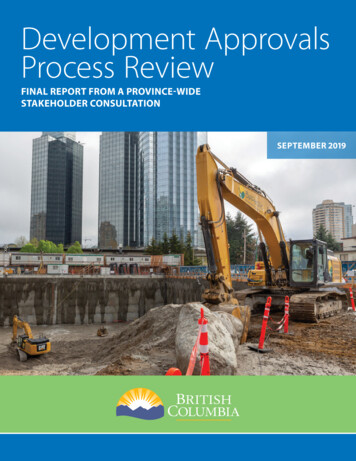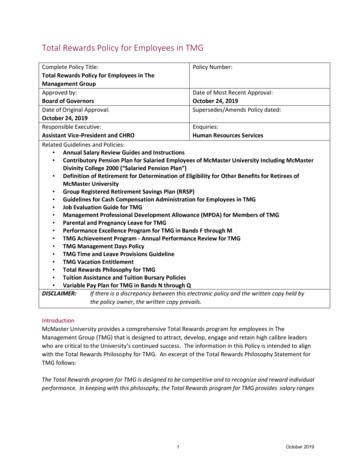
Transcription
Development ApprovalsProcess ReviewFINAL REPORT FROM A PROVINCE-WIDESTAKEHOLDER CONSULTATIONSEPTEMBER 2019
AcknowledgementsThe Ministry of Muncipal Affairs and Housing wishes to thank all theparticipants who attended and contributed to the stakeholder workinggroup and technical committees meetings. The Ministry also wants toacknowledge the work of the meeting facilitators, Pinna Sustainability Inc.and Gary Penway Consulting.2 FINAL REPORT ON DAPR CONSULTATION
Executive SummaryIn February 2018, the Minister of Municipal Affairs andHousing released Homes for B.C.: Government’s 30-PointPlan for Housing Affordability in British Columbia. Localgovernments are an important partner in this work,and government is committed to empowering andsupporting their efforts to accelerate the constructionof the homes people need.The process for approving development has a majorimpact on how quickly housing projects are built.While local government development approvals playan important role in ensuring community interests aremet and developments are healthy and safe, they canalso result in complex, lengthy and expensive processeswith significant uncertainties for developers.Expectations of development have changed significantly over the pastfew decades. Affordable housing and climate mitigation are now regularlyaddressed in the development process, and there are expectationsthat development will also deliver public amenities. Meanwhile, thedevelopment industry has also grown and changed and is now one of thelargest industries in British Columbia (B.C.). As the sector grows, increasingcompetition for building sites has resulted in shorter option periods whenacquiring land, creating greater risk for developers and heightening theirneed for more certainty at the outset of the development process.To address challenges and identify opportunities for improvementin the current development approvals process, and to support localgovernments in eliminating barriers to affordable housing and acceleratethe construction of the homes they need in their communities, theMinistry of Municipal Affairs and Housing (MAH) has initiated theDevelopment Approvals Process Review (DAPR). As a first step, MAHengaged a broad range of stakeholders to discuss the challenges of thecurrent development approvals process in B.C., to identify opportunities foraddressing those challenges and to develop an informed list of ideas abouthow to improve the efficiency and effectiveness of the process.The consultation (DAPR Phases 1-3) was broad in scope and considered afull range of legislated and non-legislated elements of the process, as wellas regional differences across the province. Over the course of six months,stakeholders contributed their knowledge, experience and perspectivesto inform potential future changes to the local government developmentapproval process.FINAL REPORT ON DAPR CONSULTATION 3
Challenges and corresponding opportunities to address them identifiedthrough the DAPR discussions were ranked by stakeholders according totheir level of importance. Collectively, the highest ranked of these weregrouped into six main categories:įį Local government applicationprocesses, including process variationsacross local government approvals,and developer applications.įį Local government approval processes,including delegation of authority on landuse permits, and the requirement andprocesses associated with public input.įį Development finance tools, including thescope and use of development cost chargesand community amenity contributions.įį Subdivision, including the role of approvingofficers, the use of preliminary layout approvals,and requirements for parkland dedication.įį Provincial referrals and regulatory requirements,including referrals to, approvals from, and permits authorized byprovincial ministries, Crown corporations and major utilities.įį Other overarching themes, including opportunities to improvebroad understanding of the development approvals process throughtraining, guides and resources, and cross-jurisdictional research.Looking ahead, the next stages of DAPR will require a thoughtfulevaluation of the range of identified opportunities. Ongoing collaborationwith stakeholders will be a critical element of this process, as many of theidentified ideas could have significant implications for local governmentsand other stakeholders.MAH is committed to ensuring that work undertaken to explore andimplement any of the opportunities identified in this report is fullyinformed by the knowledge and experience of those who are directlyworking with and impacted by development approval processes.4 FINAL REPORT ON DAPR CONSULTATION
ContentsACKNOWLEDGEMENTS. . . . . . . . . . . . . . . . . . . . . . . . . . . . . . . . . . . . . . . . . . . . . . . 2EXECUTIVE SUMMARY. . . . . . . . . . . . . . . . . . . . . . . . . . . . . . . . . . . . . . . . . . . . . . . . 31 CONTEXT. . . . . . . . . . . . . . . . . . . . . . . . . . . . . . . . . . . . . . . . . . . . . . . . . . . . . . . . . . . . 62 PROJECT PURPOSE, OBJECTIVES AND SCOPE . . . . . . . . . . . . . . . . . . . 72.1 Project purpose. . . . . . . . . . . . . . . . . . . . . . . . . . . . . . . . . . . . . . . . . . . . . . . . . . . . 72.2 Consultation scope. . . . . . . . . . . . . . . . . . . . . . . . . . . . . . . . . . . . . . . . . . . . . . . . 72.3 Development Approvals Review Working Groupand Technical Committees. . . . . . . . . . . . . . . . . . . . . . . . . . . . . . . . . . . . . . . . . . . . . 82.4 Process overview and timeline . . . . . . . . . . . . . . . . . . . . . . . . . . . . . . . . . . . . 83 GUIDING PRINCIPLES FORDEVELOPMENT APPROVALS PROCESSES . . . . . . . . . . . . . . . . . . . . . . . 104 KEY INSIGHTS ON IMPROVING DEVELOPMENTAPPROVALS PROCESSES. . . . . . . . . . . . . . . . . . . . . . . . . . . . . . . . . . . . . . . . . . 124.1 Local government application processes. . . . . . . . . . . . . . . . . . . . . . . . . . . 124.2 Local government approval processes . . . . . . . . . . . . . . . . . . . . . . . . . . . . 144.2a Delegation of authority. . . . . . . . . . . . . . . . . . . . . . . . . . . . . . . . . . . . . . . . . . 144.2b Public input process . . . . . . . . . . . . . . . . . . . . . . . . . . . . . . . . . . . . . . . . . . . . . . 154.3 Development finance tools. . . . . . . . . . . . . . . . . . . . . . . . . . . . . . . . . . . . . . . 164.4 Subdivision. . . . . . . . . . . . . . . . . . . . . . . . . . . . . . . . . . . . . . . . . . . . . . . . . . . . . . . . 174.5 Provincial referrals and regulatory requirements. . . . . . . . . . . . . . . . . . . 194.6 Overarching topics. . . . . . . . . . . . . . . . . . . . . . . . . . . . . . . . . . . . . . . . . . . . . . . . 215 CONCLUSION AND NEXT STEPS . . . . . . . . . . . . . . . . . . . . . . . . . . . . . . . . . . 226 APPENDIX A: LIST OF PARTICIPANTS . . . . . . . . . . . . . . . . . . . . . . . . . . . . 237 APPENDIX B: LIST OF OPPORTUNITIES . . . . . . . . . . . . . . . . . . . . . . . . . . 268 APPENDIX C: LEVEL OF EFFORT HIGHLIGHTS. . . . . . . . . . . . . . . . . . . 32FINAL REPORT ON DAPR CONSULTATION 5
1 ContextIn February of 2018, the Minister of Municipal Affairsand Housing released Homes for B.C.: Government’s30-Point Plan for Housing Affordability in BritishColumbia. Under this plan, the Province committedto a number of measures to stabilize the housingmarket, crack down on tax fraud and close loopholes,build the homes people need, improve security forrenters, and support the building and preservationof affordable housing. Local governments are animportant partner in this work, and government iscommitted to empowering and supporting theirefforts to accelerate the construction of homes thatpeople need.While building and preserving affordable housingis a critical part of improving the housing market,providing a supply of different types of housing alsoplays an important role in ensuring that all BritishColumbians have access to the homes they need.The process for approving development has a majorimpact on how quickly projects, including housing,are built.The Local Government Act provides local governmentsin B.C. with a variety of planning and land usetools. These include regional growth strategies,official community plans (OCPs), zoning bylaws,development permits, development cost charges,density bonusing, subdivision and developmentcontrol bylaws.1 The Community Charter provideslocal governments with tools for building bylaws.Local governments may vary some of the aboveprovisions by issuing development variance permits,temporary use permits, and heritage alterationpermits. Minimum content and public inputrequirements for these planning and land use toolsare also described in legislation. Other tools, such ascommunity amenity contributions and additional12public input processes, are not legislated but arecommonly employed by local governments in theirdevelopment approval processes.Local governments have considerable discretion overthe use of these tools to plan for their communities,achieve land use control and approve individualdevelopment proposals. Each local governmentdevelops its own requirements and follows itsown process for development approvals. Often,these vary widely between local governments,including adjacent ones, adding an additional layerof complexity for developers while also recognizingthe differences among communities.On the development side of the equation, thedevelopment sector has grown and changedover the past few decades to become one of thelargest industries in the province. In 2017, residentialdevelopment alone was responsible for nearly 12billion in wages and nearly 200,000 jobs.2 Strongdemand has increased competition for building sites,particularly in high-growth areas, resulting in shorteroption periods when acquiring land. This createsgreater risk for developers and heightens the needfor more certainty at the outset of the developmentprocess.To address challenges and identify opportunitiesfor improvement in the current developmentapprovals process, and to support local governmentsin eliminating barriers to affordable housing andaccelerate the construction of new homes, Ministryof Municipal Affairs and Housing (MAH) initiated theDevelopment Approvals Process Review (DAPR).Section 2 outlines the project purpose, objectivesand scope of the DAPR stakeholder consultations.City of Vancouver gets its authority from the Vancouver Charter.Canadian Home Builders’ Association– Economic Impacts of Residential Construction6 FINAL REPORT ON DAPR CONSULTATION
2 Project purpose, objectives and scope2.1 Project Purpose2.2 Consultation ScopeMAH initiated DAPR as part of its commitmentto empower local governments to eliminate barriersto affordable housing and accelerate the constructionof homes people need. More specifically, DAPRidentifies opportunities to increase the efficiency(including timeliness, predictability, certainty andconsistency) and effectiveness (including fairness,balance, transparency, inclusivity, and outcomesthat are in the public interest) of local governmentdevelopment approvals processes.The scope of the DAPR consultations addressed thewide range of considerations, processes and toolsassociated with the development approvals process,including legislated and non-legislated elements(Figure 1).The DAPR project consists of four phases, with thefirst three focusing on stakeholder consultation.The primary objective of the consultation wasto engage stakeholders in a robust conversationto identify:Consultations were province-wide and addressedchallenges, tools, and processes in rural, urban andsuburban communities.Eleven meetings were held throughout the provinceto provide stakeholders with an opportunity to reflecton current approaches, identify challenges andopportunities, and to suggest ideas for increasing theefficiency and effectiveness of development approvalprocesses.įį challenges within current developmentapproval processes;įį core qualities of an effective and efficientdevelopment approval process; andįį opportunities to address challenges whileimproving the efficiency and effectivenessof the development approval process.During phase four, MAH will further consider andanalyze particular opportunities, in consultationwith stakeholders, and implement solutions asappropriate.The goal of this report is to reflect the list of informedideas generated by the stakeholder consultationin phases one, two and three.Figure 1. Elements of the Development ApprovalsProcess ReviewFINAL REPORT ON DAPR CONSULTATION 7
2.3 Development Approvals ProcessReview Working Group and TechnicalCommitteesStakeholder consultations were undertaken with theparticipation of a Development Approvals ProcessReview Working Group (Working Group) and fourDevelopment Approvals Process Review TechnicalCommittees (Technical Committees).The consultation was led by the WorkingGroup, which was comprised of executive-levelrepresentatives from a range of stakeholder groupsincluding: local government, industry, non-profitorganizations, academia and other relevant agencies.The role of the Working Group was to provide criticalinput on issues and opportunities to improve theeffectiveness and efficiency of the local developmentapprovals process. The Working Group prioritizedareas for more in-depth analysis by the TechnicalCommittees and validated the action ideas that weregenerated.The regional Technical Committees were comprisedof senior and technical-level staff from the samestakeholder sectors as the Working Group. Intotal, four regional Technical Committees wereconvened, representing the North, Okanagan andInterior, Lower Mainland and Vancouver Island. TheTechnical Committees were tasked with analyzingand proposing implementable actions in responseto challenges and opportunities identified by theWorking Group.Appendix A contains a list of participants.2.4 Process overview and timelineThis section describes the consultation process withthe Working Group and Technical Committees thatoccurred over the first three phases of DAPR (Figure 2,Table 1).Figure 2. Phases of the Development Approvals Process Review8 FINAL REPORT ON DAPR CONSULTATION
PHASE 1:EXPLORATORYTable 1: DAPR process descriptionPRIMARYGOALFormatGENERATING IDEASFive meetings (one Working Group, four Technical Committee)December 2018 - January 2019Focusįį Participants each identified challenges they currently experience with thedevelopment approvals process as well as opportunities that may help to addressthe challenges, thereby increasing the efficiency and effectiveness of the process.Primary GoalDiscussing and ranking opportunities identified in Phase 1FormatFive meetings (one Working Group, four Technical Committee)PHASE 3:VALIDATIONPHASE 2:TECHNICAL ANALYSISFebruary - March 2019Focusįį The Working Group undertook an initial review of each opportunity identifiedduring Phase 1 and assessed them as follows: out of scope or not supported; needsmore discussion or definition; opportunity is worth further consideration by MAH.įį Opportunities categorized as requiring further discussion or recommendedfor consideration by MAH were moved forward for Technical Committeereview. Technical Committee participants then provided their insightson each opportunity and considered the level of importance theopportunity had in its ability to improve the development approvalsprocess by supporting one or more of the guiding principles (see section 3).Additionally, they considered the level of effort that would be required toimplement the opportunity, from the perspective of their organization.Primary GoalReviewing and confirming the ideas brought forward in Phase 1 and 2FormatOne meeting (Working Group)May 2019FocusWorking Group participants provided feedback on the three groups of opportunitiesidentified as being highest priority by the Technical Committees:įį Improving public input tools and requirements;įį Revising community amenity contributions and development cost charges;PHASE 4:INITIATE SOLUTIONSįį Updating delegated authority tools and practices.Primary GoalMAH staff to review ideas, analyze next steps and plan for implementationFormatTo be determined, in consultation with stakeholdersFocusTo be determined.FINAL REPORT ON DAPR CONSULTATION 9
3 Guiding principles forDevelopment Approvals Processes2. CERTAINTYThe requirements, timeframes and costs ofdevelopment approvals are clearly outlined andcommunicated in advance or as early as possiblein the application process. The expectations remainconsistent throughout the process.3. TRANSPARENT ACCESS TO INFORMATIONDecisions during the approval process aredocumented and communicated in a clear andtimely manner. Application status is accessible toproponents and to all staff involved in the approvalprocess. The public is informed.4. COLLABORATIVELocal governments and applicants workcollaboratively to achieve desired outcomes. Wherepublic involvement is appropriate, the process seekspublic input early in the process and in an informedmanner.During the stakeholder consultation, participants ofboth the working group and technical committeesidentified qualities of an efficient and effectivedevelopment approvals process. The qualities wereestablished as a set of guiding principles and usedto consider and frame potential opportunitiesthroughout the course of the discussions. The guidingprinciples could also assist MAH as it moves forwardin its consideration of next steps.1. ACHIEVES OUTCOMES IN THE PUBLIC INTERESTThe approvals process is set up to supportdevelopment that is strategically aligned withadopted community plans, supports communityvalues, is strategically aligned with the public interestand results in high-quality built environments.10 5. FLEXIBLEThe process achieves consistency while providingflexibility that enables developments in line withthese guiding principles. Flexibility also allows forand even rewards innovation.6. TIMELYThe development approval process occurs ontimeframes that are appropriate to the level ofcomplexity of the application. All parties, includinglocal governments, proponents, provincial agencies,professionals, and others involved in the applicationprocess, provide needed input in a timely manner.7. BALANCEDThe development approval process strives to achievea fair balance of costs and benefits to the public andthe proponent.FINAL REPORT ON DAPR CONSULTATION
4 Key insights on improvingDevelopment Approvals ProcessesThe following section outlines the ideas identified tobe of high importance by the stakeholders.3 Severalother challenges and opportunities were rankedof medium or lower importance by participants,and these are included in a comprehensive list inAppendix B. The high importance ideas are groupedinto six main topic areas, including:įį Local government application processes;įį Local government approval processes;ĉĉ Public input,ĉĉ Delegation of authority,įį Development finance tools;4.1 Local government applicationprocessesCONTEXTLocal government processes for planning and landuse are flexible, in part to allow for their applicationto a wide range of unique circumstances. In thecase of development approvals, this has resultedin considerable process variations and differingrequirements between local governments.Proponents and developers are responsible forlearning and following the development approvalprocess requirements for the communities in whichthey wish to build.įį Subdivision;įį Provincial referrals and regulatory requirements;CHALLENGESįį Overarching themes.Participants identified several elements of internalapplication processes that pose challenges for bothproponents and local governments, and increaseoverall timelines for application processing, including:įį incomplete or poor-qualitysubmissions by proponents;įį increased complexity of requirements;įį inconsistent development permit guidelines; andįį contradictory advice from different departments.Outside of lengthy application processes,other challenges raised included:įį lack of transparency on the statusof development applications, andįį lack of consistency of requirementsbetween adjacent local governments.3In the same way that the Technical Committee members ranked the relative importance of identified opportunities, they alsoranked level of effort on a scale of low, medium and high, based on individual perception of the effort that would be requiredby their organization to implement. Further assessment of implementation effort will be considered in more detail by the MAHas part of phase four. Appendix C provides a brief summary of the opportunities identified as likely to require a higher level ofeffort to implement by at least one stakeholder group.FINAL REPORT ON DAPR CONSULTATION 11
Participants also noted challenges with internal staffresourcing, particularly with respect to obtaining andretaining qualified building officials and experiencedplanning staff, and difficulties with resource planningdue to misalignment between budget requests andfluctuations in the number of applications.OPPORTUNITIESParticipants identified numerous best practices thatcan be employed by local governments to improvethe efficiency of internal reviews and approvals, withsome of these already being tested or in practice inindividual local governments. Participants highlightedthe usefulness of developing best practice guides,both for local governments and developers, andsuggested that local governments and proponentscould conduct reviews of their processes guided bythese best practices.Other opportunities considered to be of highimportance for improving application processingincluded:įį triaging development applications at thesubmission stage to identify incomplete,easy and complex applications, and havea different process for acting on each kind;įį implementing a digital permit tracking systemwhere cost effective (or with assistancefrom the provincial government);įį creating a model DevelopmentApprovals Procedures Bylaw;įį local governments to develop best practiceguide to clearly define what constitutesa major versus minor amendment change;įį creating model development checklists; andįį emphasizing the need for staff acrossdepartments to communicate, understand,and balance requirements administeredthrough development approval processes.12 While staff resourcing was considered highimportance, participants noted that it couldbe challenging to address. Some ideas on thistopic included:įį working with the development communityto find a balance between improved processingtimes and increased application and permitfees to cover the costs of additional staffing;įį provincial government support forprofessional positions in underservedregions and smaller communities;įį setting minimum liability insurancerequirements for professionals; and,įį addressing building official training,recruitment and retention.REGIONAL NOTESGenerally, opportunities for improving internalprocesses were ranked as being of lower importancein the North. Representatives from the Okanagan andInterior placed extra importance on the developmentof best practice guides, model checklists andresourcing. Mandatory application timeframes,limited to staff-approved applications, were identifiedas important on Vancouver Island; however, there wasconcern with regard to potential legal challenges andstaffing issues. Other regions also raised concernsover the practicality of mandatory timelines giventhe need for external referrals, complex applications,applicant response times, legal challenges andconsequential rejection of applications. As analternative to mandatory timelines, participantssuggested that local governments set targettimeframes for application reviews.FINAL REPORT ON DAPR CONSULTATION
4.2 Local government approvalprocessesChallenges and opportunities for local governmentapproval processes are divided into two subcategories: delegation of authority and public input.4.2a Delegation of authorityCONTEXTThe Province provides authority to local governmentsfor development approval tools under severalpieces of legislation: the Local Government Act,the Community Charter, the Building Act and theVancouver Charter, which applies to the City ofVancouver only. Legislation specifies which decisionsmust be made by elected officials, which may bedelegated to staff, and which must be made by staff.Under the current system, amendments to zoningbylaws (i.e., rezoning applications) and developmentvariance permits must be approved by electedofficials, while development permits, temporary usepermits, and tree cutting permits may be delegated.The City of Vancouver has more flexibility and someadditional powers in relation to land use matters,and has more matters that are specifically statedin legislation as delegable to staff.CHALLENGESParticipants identified that some types of approvalsby elected officials can increase overall timeframes,potentially impacting project costs, particularlyas agendas for council and board meetings arefrequently full and applications may need to waitseveral weeks before being heard. Elected officialapproval may lead to uncertainty – in somecircumstances projects may meet required criteriaand are not approved due to subjective requirementsfrom council.FINAL REPORT ON DAPR CONSULTATIONMany participants questioned whether elected officialapprovals were necessary in cases where applicationsare aligned with the OCP, council/board-approvedarea plans, or development permit area guidelines.Concerns were raised regarding elected officialsmaking decisions on development applicationsbased on details that are not supposed to be takeninto account (e.g., making a decision on the intendedusers of a proposed development instead of theintended use), either due to pressure from the publicor lack of understanding about the parameters ofevaluation.OPPORTUNITIESThere was significant interest in and high importanceplaced on increasing opportunities for localgovernments to delegate approval decisions tostaff. This suggestion was provided in the contextthat greater emphasis should be placed on thedevelopment of area plans and pre-zoning that havebeen subject to robust public input. The approvalof applications that align with these plans couldthen be delegated to staff, helping to make theapproval process more efficient while maintainingits effectiveness. Participants identified the followingaction ideas:įį Conduct a review of opportunities to increasecouncils’ and boards’ ability to delegateindividual development approvals.įį Reframe legislation to make delegation the defaultapproach for some approvals, with the optionto opt into elected official decision-making.įį In the case of a new delegation authority,provide an option for applicants receivingdelegated approvals to appeal staffdecisions to elected officials.įį Provide training to local governments and/or create best practices guide on conductinga meaningful and robust public consultationprocess for OCP and pre-zoning, then delegateapproval of subsequent applications. 13
įį Enable conditional/discretionary uses for all localgovernments, similar to Vancouver, and delegateapproval decision for these uses to staff.4įį Provide local governments the authority todelegate decision making to staff for minordevelopment variance permit matters (forexample, minor variances to parking, siting, etc.,that do not affect use or density and do not createa significant impact on neighbouring properties).įį Identify options for enhancing pre-zoningtools to enable local governments to securebenefits that are currently negotiatedthrough site specific rezoning.REGIONAL NOTESParticipants in the Okanagan and Interior and onVancouver Island indicated the highest levels ofsupport for these opportunities.4.2b Public input processCONTEXTMinimum requirements for public input areestablished by legislation, with public hearingshaving an additional framework set out in commonlaw. For example, legislation does not address whatcan be heard after a public hearing and before adecision, yet there are very strict rules about thisthat have been created by the courts. This makesthe public hearing context different than most otherland use and planning provisions. Public hearings arerequired for all development applications that seekamendments to OCPs and to zoning bylaws that arenot consistent with the OCP. Public hearings can bewaived for rezonings that are consistent with theOCP; however, many local governments choose tohold a public hearing regardless.4Public hearings must be held after first reading andbefore third reading of a bylaw. The public hearing,third reading and adoption can occur in one meeting.Earlier opportunities for public input are not requiredin legislation; however, many local governments havecreated their own processes for meaningful publicengagement earlier in the process. Similarly, whilethere are no requirements for proponents to engagewith the public at any point in the process, manychoose to do so.CHALLENGESParticipants noted that in general, public hearingstend to be an ineffective means of engaging andreceiving input from the public, in particular:įį The format of a public hearing does not allowfor discussion. Councils and boards may notrespond to the comments from the public, whichcan cause frustration on the part of the public.įį Public hearings occur late in the developmentapprovals process, after considerable time(sometimes years) and significant cost hasgone into a proposed project. Consequently,change can be difficult to accommodate.įį Public hearings tend to attract and empower wellorganized interest groups that may not representthe broad perspective of the community or eventhose who would be the most directly impactedby a decision. This can result in applications beingdenied despite being aligned with adoptedcommunity and neighbourhood plans. Publichearings can enab
broad understanding of the development approvals process through training, guides and resources, and cross-jurisdictional research. Looking ahead, the next stages of DAPR will require a thoughtful evaluation of the range of identified opportunities. Ongoing collaboration with stakeholders will be a critical element of this process, as many of the










